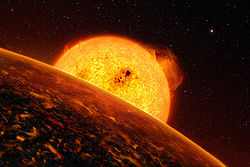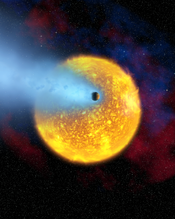- Chthonian planet
-
 Artist's conception of COROT-7b.
Artist's conception of COROT-7b.
 Artist's conception of HD 209458 b transiting its star.
Artist's conception of HD 209458 b transiting its star.
A chthonian planet (
 /ˈkθoʊniən/, sometimes misspelled 'cthonian') is a hypothetical class of celestial objects resulting from the stripping away of a gas giant's hydrogen and helium atmosphere and outer layers, which is called hydrodynamic escape. Such atmospheric stripping is a likely result of proximity to a star. The remaining rocky or metallic core would resemble a terrestrial planet in many respects.[1]
/ˈkθoʊniən/, sometimes misspelled 'cthonian') is a hypothetical class of celestial objects resulting from the stripping away of a gas giant's hydrogen and helium atmosphere and outer layers, which is called hydrodynamic escape. Such atmospheric stripping is a likely result of proximity to a star. The remaining rocky or metallic core would resemble a terrestrial planet in many respects.[1]HD 209458 b is an example of a planet that is in the process of having its atmosphere stripped away, though it is not itself a chthonian planet nor is it expected to become one in the near future.
COROT-7 b may be the first chthonian planet discovered.[2][3] Kepler-10b is also the second chthonian planet found.
Chthonia (from Greek: χθων) means "of the Earth". The term was coined by Hébrard et al., since the term chthonian generally refers to Greek deities from the infernal underground.
See also
- Hot Jupiter
- COROT-7b: diameter 1.7 x Earth, mass 4.8 x Earth, orbital period = 20.5 hours[4] (super-Earth candidate)
- Hypothetical planet
References
- ^ Hébrard G., Lecavelier Des Étangs A., Vidal-Madjar A., Désert J.-M., Ferlet R. (2003), Evaporation Rate of Hot Jupiters and Formation of chthonian Planets, Extrasolar Planets: Today and Tomorrow, ASP Conference Proceedings, Vol. 321, held 30 June - 4 July 2003, Institut d'astrophysique de Paris, France. Edited by Jean-Philippe Beaulieu, Alain Lecavelier des Étangs and Caroline Terquem.
- ^ "Exoplanets Exposed to the Core". AstroBiology Magazine. 2009-04-25. http://www.astrobio.net/index.php?option=com_news&task=detail&id=3105. Retrieved 2009-07-13.
- ^ "Super-Earth 'began as gas giant'". BBC News. 10 January 2010. http://news.bbc.co.uk/1/hi/sci/tech/8446125.stm. Retrieved 2010-01-10.
- ^ "Planet : CoRoT-7 b". http://exoplanet.eu/planet.php?p1=CoRoT-7&p2=b. Retrieved 2009-06-13.
Exoplanets Classes - Carbon planet
- Coreless planet
- Desert planet
- Iron planet
- Ocean planet
- Super-Earth
- Chthonian planet
- Carbon giant
- Eccentric Jupiter
- Helium planet
- Hot Jupiter
- Hot Neptune
- Jovian planet
- Puffy planet
Other typesSystems - Binary star
- Extragalactic planet
- Extrasolar moon
- Hypothetical extrasolar planet
- Planetary system
- Rogue planet
- Trojan planet
Lists Detection- Extrasolar planets detected by radial velocity
- Transiting extrasolar planets
- Extrasolar planets detected by microlensing
- Extrasolar planets directly imaged
- Extrasolar planets detected by timing
- Unconfirmed exoplanets
Planets and host stars- Stars with extrasolar planets
- Planetary systems
- Extrasolar planet extremes
- Extrasolar planet firsts
- List of nearest terrestrial exoplanets
Surveys Exoplanets search projects Ground-based - AAPS
- California and Carnegie Planet Search
- HAT
- HARPS, part of the Geneva Extrasolar Planet Search
- MEarth Project
- MOA
- OGLE
- Magellan Planet Search Program
- SuperWASP
- TrES
- XO Telescope
- EAPSNet
- High Resolution Echelle Spectrometer (HIRES)
- MARVELS
- MUSCA
- Microlensing Follow-Up Network (MicroFUN)
- NASA-UC Eta-Earth
- PHASES
- PlanetPol
- PARAS
- Subaru telescope, using the High-Contrast Coronographic Imager for Adaptive Optics (HiCIAO)
- Systemic, an amateur search project
- ZIMPOL/CHEOPS, based at the VLT
Space missions CurrentPlanned- PEGASE (est. 2010-2012)
- TESS (est. 2013-2014)
- PLATO (est. 2017)
- New Worlds (est. 2020)
- EChO (est. 2022)
Other status- See also:
- List of extrasolar planets
- Discoveries of extrasolar planets
- Unconfirmed exoplanets
- Detection methods
See also: Discoveries of extrasolar planets Categories:- Hypothetical planet types
- Astronomy stubs
Wikimedia Foundation. 2010.
